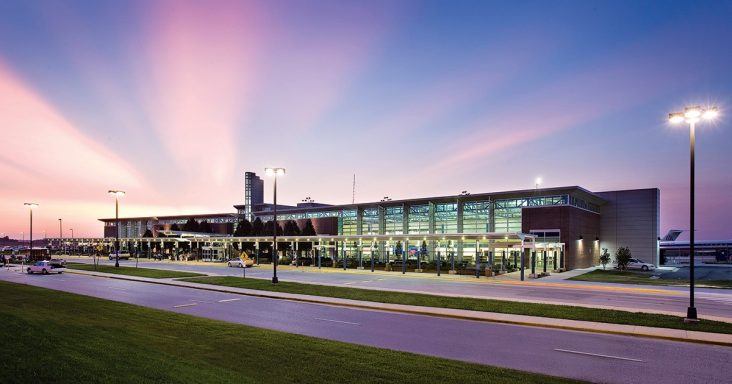XNA considers air quality improvements to increase enplanements, reduce sick time
by December 2, 2020 3:08 pm 1,272 views

Northwest Arkansas National Airport (XNA) in Highfill is studying improved air cleaning and filtration systems to mitigate the spread of COVID-19 in the terminal in an effort that might lead to increased enplanements and reduced employee sick time.
Between January and October, enplanements, or passengers flying out, have decreased by 60.4% to 304,394, from 768,650 over the same period in 2019. In October, enplanements declined by 63.7% to 31,367, from 86,554.
CEO Aaron Burkes said he projected enplanements fell by 64% in November. This would be flat from the October decline. Enplanement numbers are typically released about two weeks after the end of each month.
In a committee meeting Wednesday (Dec. 2), airport board members recommended approval for an additional $860,000 to install safety and air quality equipment throughout the terminal and pursue grants to offset the cost. XNA board members and staff discussed two proposed air cleaning systems that would cost about $1 million, according to a staff memo. In June, the board approved spending up to $200,000 to reduce the risk of virus transmission in the terminal.
Kelly Johnson, chief operating officer, said UV-C lighting units have been installed in the terminal’s air handling system for about $45,000. The airport replaced its drinking fountains with touchless units that allow for water bottle refilling for about $50,000. Also, XNA purchased an electrostatic spraying system to disinfect surfaces throughout the terminal and other buildings for $5,000. Its maintenance staff is completing the applications.
Johnson said the airport has been working with mechanical engineering company HP Engineering to receive recommendations for system upgrades and to improve indoor air quality. The two proposed systems include dry hydrogen peroxide air cleaning devices that would be installed throughout the terminal for about $900,000 and bipolar ionization air-cleaning devices placed at each heating, ventilation, and air conditioning unit for nearly $100,000. Trane would handle the installation.
“We were participating in a call of peer airport groups about what they are doing about the air in the building, and Dallas, Texas, had done a project where they tested three different systems,” Johnson said. “And the dry hydrogen peroxide was one they were quite shocked about how effective it was. It has the added benefit of not only cleaning the air but also cleans the surfaces.”
The dry hydrogen peroxide system also affects insects and has reduced pests, leading to lower pest control costs, Johnson said.
A Trane representative said the bipolar ionization air cleaning device only cleans the air that runs through the system. The devices are installed after the cooling coils and create positive and negative ions to break down viruses, bacteria and mold.
Because the $1 million in new systems would exceed the $200,000 the board allocated in June, staff requested the additional $860,000 for them. Board members will decide on Dec. 16 whether to approve the additional money. Burkes said the airport is still studying the systems, and because the board won’t meet again until February, staff wanted to ask for approval to acquire the best system.
Investments into such systems are expected to improve safety for passengers and employees and increase consumer confidence in the airport’s efforts to keep them safe, the staff memo shows. It noted “this effort could potentially result in increased enplanements and reduced sick time for employees.”
Johnson cited a recent Los Angeles International Airport passenger survey showing the greatest concern was about the air quality in the terminal. XNA has completed some changes that could be made quickly such as circulating more outside air into the terminal and exhausting air as fast as possible in smaller and contained spaces, such as restrooms, she said. Exhaust fans are constantly running in those spaces. The airport maintains indoor humidity levels and keeps units free of mold and microorganisms.
However, she said, the air circulation system is more effective in some areas of the terminal than it is in others. A recommendation was to increase the filtration level of the filters to Minimum Efficiency Reporting Value (MERV) 14, she said. The airport uses MERV 10 filters but will test how the MERV 14 filters affect airflow.
Board member Mike Johnson, who’s associate vice chancellor for facilities management at the University of Arkansas, said the UA has looked into installing MERV 13 filters and is the level at which they start to have the most impact on the virus that causes COVID. However, orders placed over the summer had yet to be fulfilled. Some of the material is also used in N95 masks, which is a higher priority, he said.
“We realize that there’s a vaccine coming, and that sounds great,” Kelly Johnson said. “People will generally have short-term memory once you get past something.” She recalled H1N1, SARS and Ebola and planning for those outbreaks with the state health department.
“We don’t want to say that this isn’t necessary after this virus is defeated because there will be another one coming down the road,” she said.
